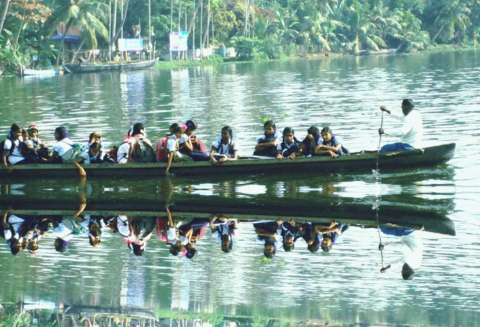
Anna Akter, a nine-year-old student at a floating school in Bangladesh's remote Natore district, says she might have missed out on her education during annual floods without her boat-based classroom. The same goes for Khushi Khatun, who also studies at the boat school where she gets free tuition and materials. “Had there been no such school, she would have had to walk two kilometers along a muddy path or take a boat journey which may have discouraged her from studying,” said her father Nazir Uddin, a farmer in Pangasia village.
本时文内容由奇速英语国际教育研究院原创编写,未经书面授权,禁止复制和任何商业用途,版权所有,侵权必究!(投稿及合作联系:028-84400718 QQ:757722345)
1.Why did the writer mention Anna Akter in the first paragraph?
A To show the importance of education.
B To introduce a new kind of school.
C To tell people her life is unhappy.
D To explain she had trouble learning.
解析:选B。推理判断题。根据文章第一段第一句Anna Akter, a nine-year-old student at a floating school in Bangladesh's remote Natore district可以得知提到她就是为了引入船上学校这一话题,故选B。
2.What made the boat school appear?
A Free tuition.
B Remote position.
C The great floods.
D Many materials.
解析:选C。细节理解题。根据文章第二段第一句Hundreds of students in the northern Bangladesh district are taught in floating schools.可知是洪水促使了船上学校的出现,故选C。
3.How did the children go to the boat school?
A They went to school by bike.
B They walked to school by themselves.
C They took the bus to school.
D The boat would pick them up from riverside stops.
解析:选D。D。推理判断题。根据第二段第三句The boats first serve as school bus, collecting children from different riverside stops可以得知用作教室的船去河边站接孩子上学,故选D。
4.How many students are studying in Rezwan’s organization?
A About 1.5 million.
B About 660.
C About 30.
D About 22.
解析:选B。B。细节理解题。根据文章第二段最后一句Rezwan’s organization now has 22 wooden boats, each able to hold 30 students可知大约有660名学生在这个组织的船上学校上学,故选B。
5.What kind of education can adult villagers receive in the boat school?
A Computer science.
B Farming skills.
C Driving boats.
D Teaching children.
解析:选B。B。细节理解题。根据文章第三段最后一句and how to farm ducks and fish alongside vegetables in “floating gardens”可知该学校还教村民们如何养鸭子等相关的农业知识,故选B。